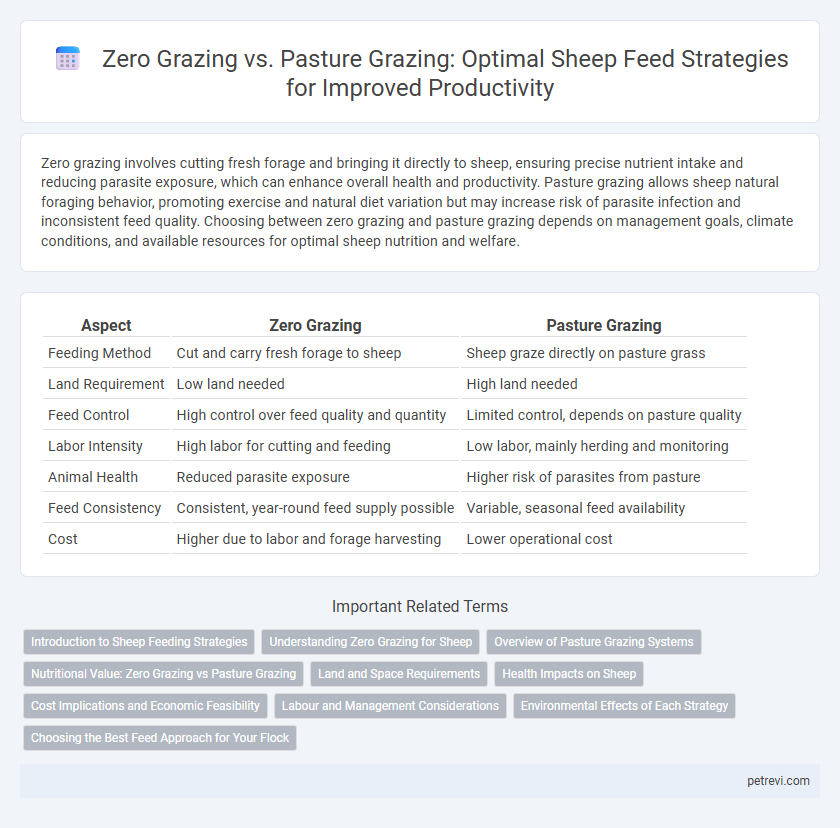Zero grazing involves cutting fresh forage and bringing it directly to sheep, ensuring precise nutrient intake and reducing parasite exposure, which can enhance overall health and productivity. Pasture grazing allows sheep natural foraging behavior, promoting exercise and natural diet variation but may increase risk of parasite infection and inconsistent feed quality. Choosing between zero grazing and pasture grazing depends on management goals, climate conditions, and available resources for optimal sheep nutrition and welfare.
Table of Comparison
| Aspect | Zero Grazing | Pasture Grazing |
|---|---|---|
| Feeding Method | Cut and carry fresh forage to sheep | Sheep graze directly on pasture grass |
| Land Requirement | Low land needed | High land needed |
| Feed Control | High control over feed quality and quantity | Limited control, depends on pasture quality |
| Labor Intensity | High labor for cutting and feeding | Low labor, mainly herding and monitoring |
| Animal Health | Reduced parasite exposure | Higher risk of parasites from pasture |
| Feed Consistency | Consistent, year-round feed supply possible | Variable, seasonal feed availability |
| Cost | Higher due to labor and forage harvesting | Lower operational cost |
Introduction to Sheep Feeding Strategies
Zero grazing involves harvesting forage and delivering it to sheep, ensuring controlled nutrition and minimizing land degradation, while pasture grazing allows sheep to feed directly on growing grasses, promoting natural foraging behavior and nutrient intake. Zero grazing suits intensive systems requiring precise feed management, whereas pasture grazing supports extensive systems with lower labor input and greater movement freedom for sheep. Balancing these strategies optimizes feed efficiency, animal health, and sustainable land use in sheep production.
Understanding Zero Grazing for Sheep
Zero grazing involves cutting and transporting fresh forage to sheep housed in confined spaces, maximizing feed control and minimizing land use. This method reduces parasite exposure and improves nutritional management compared to pasture grazing, where sheep consume forage directly on open fields. Implementing zero grazing requires careful planning of forage growth cycles and storage to maintain consistent feed quality for optimal sheep health and productivity.
Overview of Pasture Grazing Systems
Pasture grazing systems for sheep involve allowing flocks to feed directly on natural or cultivated grasslands, which promotes natural foraging behavior and nutrient intake. These systems enhance soil health through natural fertilization and reduce feed costs compared to zero grazing methods. Proper management of pasture rotation and stocking density is crucial for maintaining pasture quality and preventing overgrazing.
Nutritional Value: Zero Grazing vs Pasture Grazing
Zero grazing provides controlled, high-quality fodder, ensuring consistent nutrient intake rich in protein and minerals essential for sheep growth and wool production. Pasture grazing offers diverse plant species that contribute to balanced nutrition but may vary seasonally, affecting nutrient availability and sheep health. Optimizing feed strategy requires balancing the steady nutrient profile of zero grazing with the natural diversity and fiber content found in pasture grazing.
Land and Space Requirements
Zero grazing for sheep drastically reduces land and space requirements by confining animals to a controlled environment where all feed is cut and transported, making it ideal for areas with limited pasture availability. Pasture grazing demands extensive land to sustain sufficient forage growth, requiring rotational grazing systems to prevent overgrazing and maintain soil health. Optimal feed strategy selection depends on balancing land resources, labor intensity, and sustainability goals to maximize sheep productivity and welfare.
Health Impacts on Sheep
Zero grazing reduces parasite exposure by limiting sheep's contact with contaminated pasture, lowering the risk of internal and external infections. Pasture grazing promotes natural foraging behavior and provides varied nutrients, supporting a stronger immune system and overall vitality. However, pasture grazing increases exposure to pathogens and parasites, potentially compromising sheep health if pasture management is inadequate.
Cost Implications and Economic Feasibility
Zero grazing requires higher initial investment in infrastructure and feed procurement but reduces land use and allows precise dietary control, resulting in potentially higher feed efficiency and reduced disease risk. Pasture grazing lowers feed and infrastructure costs by utilizing natural forage, but fluctuating pasture quality and availability can affect sheep growth rates and overall productivity. Economic feasibility depends on farm size, available capital, labor costs, and local forage conditions, with zero grazing often favored in intensively managed, high-input systems and pasture grazing suited for extensive, low-input operations.
Labour and Management Considerations
Zero grazing requires intensive labour input for daily cutting, carrying, and feeding of fodder, demanding meticulous management to maintain feed quality and prevent spoilage. Pasture grazing reduces labour needs by allowing sheep to self-feed, but it necessitates regular pasture rotation and monitoring to avoid overgrazing and maintain soil health. Effective management in zero grazing involves precise feed planning and hygiene control, while pasture grazing depends on adequate pasture availability and strategic grazing schedules.
Environmental Effects of Each Strategy
Zero grazing minimizes land degradation and soil erosion by confining sheep to controlled feeding areas, reducing overgrazing and promoting nutrient recycling through managed manure collection. Pasture grazing supports biodiversity and natural soil fertility but can lead to overgrazing, compaction, and methane emissions if not properly managed. Sustainable sheep feed strategies must balance these environmental impacts to optimize land use efficiency and ecosystem health.
Choosing the Best Feed Approach for Your Flock
Zero grazing offers precise control over sheep nutrition by providing freshly cut forage, reducing parasite risks and ensuring consistent feed quality compared to pasture grazing. Pasture grazing allows natural foraging behavior, reduces feeding costs, and promotes animal welfare but may expose sheep to variable forage quality and parasite load. Selecting the best feed approach depends on flock size, land availability, management capacity, and disease control priorities to optimize sheep health and productivity.
Zero Grazing vs Pasture Grazing for Sheep Feed Strategy Infographic

 petrevi.com
petrevi.com